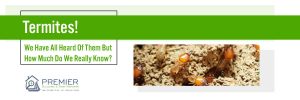
Everyone has heard of termites and its common knowledge that they can eat through homes if left to their own devices but what else should you know about them? Your property is a significant investment, and you want to be sure it is protected from these wood loving pests.
Areas Most At Risk
Termites thrive, multiply, and destroy homes in warm parts of the country. This is why you won’t find them in cooler states such as Tasmania. The warmer the climate, the higher the risk it is that you will experience a termite infestation.
Termites Do Not Stop
Unlike humans and animals who need to sleep to function, termites do not. They eat, build and work 24/7 which allows them to do substantial damage in a short space of time.
Types Of Termites
Australia has over 300 species of termites and while that is a lot not all pose a risk to your property. Subterranean termites wreak the most havoc on homes and use their strong jaws to bite off small pieces of wood.
They Temperature Control Their Nests
Termites need moisture and humidity to survive and they get this from the ground, rotting timber or water leaks. The tunnels are kept moist and air pockets built throughout their nest, this allows airflow through to maintain efficiency.
They Don’t Just Eat Wood
Termites feed off a substance called cellulose which is found in all plant matter. Termite nests are often situated away from the home and they make their way to your property in their travels to find a food source. Many opt to have steel frames rather than timber when constructing a new home and while this does limit the amount of wood they can eat, they can still attack timber fittings, furniture, and trusses within the home.
A Queen Can Live For More Than 50 Years
A termite nest consists of workers, soldiers, and queens. Each plays a key role in ensuring the colony is running to its full potential. A queen is the matriarch of the nest and can live for more than 50 years. Some species of termite queens can lay thousands of eggs per day which injects thousands of new workers and soldiers into the colony allowing the damage to your home to become more widespread and extensive.
The Potential Damage
While it may be easy to assume that termites are small so therefore the destruction is only significant when left untreated for decades, however, this couldn’t be further from the truth. It only takes termites six months to do substantial and costly damage to a home.
Invisible Destroyers
You may think you don’t have termites because if you did you would have seen or heard them by now. More times than not people are oblivious to the fact that termites are eating away at their home until an inspection is conducted. Termites usually live under the ground where it is moist and the excavate the soil to navigate their way to the home. They get in via paper-thin cracks in the concrete slab, plumbing, and joints. These pests usually eat the inner portion of the wood leaving behind the outer surface to protect them from the elements and predators. Underground is the perfect place for subterranean termites to live as dirt retains moisture which protects them from drying out. Termites are very good at disguising themselves. Don’t make the mistake of falling into this trap and waiting until you notice damage to call out an inspector or terminator.
What They Look Like
Termites are often mistaken as ants but on closer inspection, there are some distinctive differences. Depending on what type of termite they are the colour can vary although they are typically white, black, or brown. Termites have two parts, their head and body whereas ants are made up of three. Termites have wide straight bodies, ants on the other hand appear pinched in at the sides. Another way to differentiate between the two is by looking at their wings. Both have two wings on each side but ants wings are different sizes, termites are the same.
Most Insurance Companies Will Not Cover Termite Damage
Home insurers will usually only cover unforeseeable and sudden circumstances. Insurance companies have a strict stance on not covering termite damage as they believe it is a preventable issue. Significant damage happens gradually over time, so if you have regular inspections, they would be picked up before they have a chance to destroy your property. Putting off an inspection until you notice the signs of termites can see you forking out hundreds if not thousands of dollars to rectify the problem, unfortunately with no compensation from your insurer.
Termite Prevention And Treatment
Prevention – Like they always say prevention is better than a cure. To deter termites from invading your home, you should have preventive measures in place and get your home inspected annually by a professional.
Treatment – If you have termites at your home, it’s best to call in an exterminator to treat them as soon as you can. They will advise you of the suitable treatment options.
If you have any questions regarding termite inspections and treatments, get in touch with our experienced termite eradication team here at Premier Building and Pest Reports or check out our website for more information.
